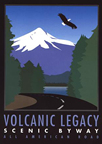History
The Volcanic Legacy Scenic Byway contains rich history.
Please follow the links below to discover information on the history found along the Volcanic Legacy Byway.
Local Native Americans witnessed the collapse of Mount Mazama and kept the event alive in their legends. One ancient legend of the Klamath people closely parallels the geologic story which emerges from today's scientific research. Follow this link to read more about Crater Lake's Park History . Also check out the National Register for Historic Places.
The Klamath Tribes gathered wokas seed pods from the vast marshes and processed them into one of the staple foods of this highly specialized marsh, lake, and river-based culture. Find out more about the history of the Klamath and Modoc Tribes and their annual events.
Tule Lake was the largest and most controversial of the ten War Relocation Authority WRA camps used to carry out the government’s system of exclusion and detention of persons of Japanese descent, mandated by Executive Order 9066
The history of the Modoc Indians in Butte Valley has been traced back approximately 7000 years through archaeological discoveries at Night Fire Island, adjacent to the banks of Sheepy Creek. Although their homeland is considered to be the Lost River and Tule Lake area, the Modocs roamed throughout the Butte Valley area. There are petroglyphs on Indian Point road and signs of the Modoc camp in the Pleasant Valley.
When Europeans first entered Northern California in the 1820's they found several small indian tribes. The area North of Mount Shasta was the territory of the Shasta Indians. These hunter-gatherers live in small bands and were migratory. To find out more about the history in the Mt. Shasta area visit the Mt. Shasta Collection and Sisson Museum's website .
In Lassen County Roop's Fort / William H. Pratt Museum is the oldest structure in the town. The museum houses exhibits chronicling the last 170 years in Susanville's history. For museum information call (530) 257-3292.
The Lassen area was a meeting point for at least four American Indian groups: Atsugewi, Yana, Yahi, and Maidu. Because of its weather and snow conditions, generally high elevation, and seasonally mobile deer populations, the Lassen area was not conducive to year-round living. These Native American groups camped here in warmer months for hunting and gathering. Basket makers rather than potters, they left few artifacts other than stone points, knives, and metals. Some of these artifacts are displayed in the Loomis Museum, along with replicas of basketry and hunting devices. Visit the Lassen National Park Website to find out more about the Indians, emigrants, and historians.
- Crater Lake
- Upper Klamath Lake & Klamath Falls
- The Klamath Basin, Tulelake & Lava Beds
- Butte Valley
- Mount Shasta
- The Waterfalls, McCloud and Burney
- Hat Creek Rim
- Lassen Peak Region
- Lake Almanor
-
Interests
- Trip Planner
- Volcanic Spectacles
- Waterfalls
- Wildlife
- History
- Recreation
- Travel with Kids
- Lodging & Services
- RV & Camping
- Fishing & Hunting
- Scenic Wonders
- 2011 Calendar

 VolcanicLegacyByway.org is the Official Website for The Volcanic Legacy Scenic Byway All-American Road in California and Oregon.
VolcanicLegacyByway.org is the Official Website for The Volcanic Legacy Scenic Byway All-American Road in California and Oregon.